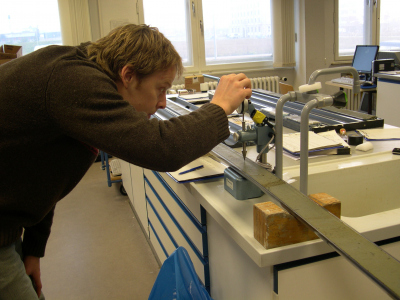Page path:
- IODP at MARUM
- Partner to the ECORD Science Operator
- Onshore Science Party (OSP)
- Core flow and procedures
- Physical Properties
- Penetration / shear strength
Penetration / shear strength
Undrained shear strength (S) of sediments can be measured using different devices. The Torvane pocket penetrometer and a fall cone have been previously used on MSPs. Offshore measurements of shear strength may be performed at the top or the bottom of an undisturbed, freshly cut section. Both the Torvane and the pocket penetrometer are handheld devices that allow for rapid determination of strength in cohesive sediment. The pocket penetrometer is more effective when sediments become slightly indurated, whereas the Torvane allows determination of shear strength in weakly and moderately indurated sediments.
The Torvane is a small, handheld, spring-loaded device with a vane blade that is pressed into the sample and turned. Strength measurements made with the Torvane are affected by changes in the amount of pressure applied to the device and the rate of rotation. Similar to the automated vane shear tests, S determinations using the handheld Torvane assume that a cylinder of sediment is uniformly sheared around the axis of the vane and remains in an undrained condition during the test. In this state, cohesion is the principal contributor to the shear strength. Violation of this assumption occurs with progressive cracking of the failing specimen, drainage of local pore pressures and stick-slip behavior.
The pocket penetrometer measures the unconfined compressive strength of sediments, which, in an ideal clay, is equal to twice S (Holts and Kovacs, 1981). Measurements are made by pressing the retracting head of the penetrometer into the end of the core. The amount of force required to press the head 5 mm into the sediment is read on a calibrated scale. The maximum shear strength measurable with the pocket penetrometer is 245 kPa.
The fall cone measures the penetration of a standard cone as it free falls a set distance and embeds itself into the sediment. The fall cone is generally the device used onshore. During testing, the cone is lowered so that it just touches and marks the surface of the split core before it is locked in place with the dial gauge reading noted. The cone is then released and penetrates the surface of the sample. The undrained shear strength is determined using an empirical formula (e.g., see Exp. 302 explanatory notes).
The Torvane is a small, handheld, spring-loaded device with a vane blade that is pressed into the sample and turned. Strength measurements made with the Torvane are affected by changes in the amount of pressure applied to the device and the rate of rotation. Similar to the automated vane shear tests, S determinations using the handheld Torvane assume that a cylinder of sediment is uniformly sheared around the axis of the vane and remains in an undrained condition during the test. In this state, cohesion is the principal contributor to the shear strength. Violation of this assumption occurs with progressive cracking of the failing specimen, drainage of local pore pressures and stick-slip behavior.
The pocket penetrometer measures the unconfined compressive strength of sediments, which, in an ideal clay, is equal to twice S (Holts and Kovacs, 1981). Measurements are made by pressing the retracting head of the penetrometer into the end of the core. The amount of force required to press the head 5 mm into the sediment is read on a calibrated scale. The maximum shear strength measurable with the pocket penetrometer is 245 kPa.
The fall cone measures the penetration of a standard cone as it free falls a set distance and embeds itself into the sediment. The fall cone is generally the device used onshore. During testing, the cone is lowered so that it just touches and marks the surface of the split core before it is locked in place with the dial gauge reading noted. The cone is then released and penetrates the surface of the sample. The undrained shear strength is determined using an empirical formula (e.g., see Exp. 302 explanatory notes).



